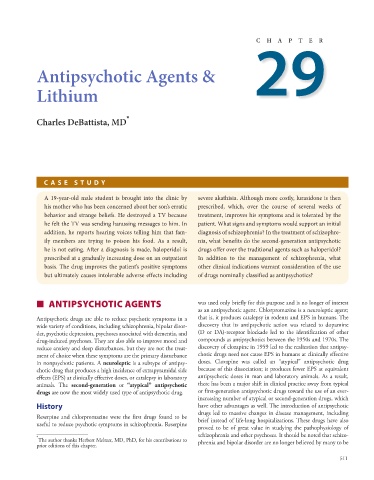Page 525 - Basic _ Clinical Pharmacology ( PDFDrive )
P. 525
29
A
P
C
H
T
R
E
Antipsychotic Agents &
Lithium
*
Charles DeBattista, MD
C ASE STUD Y
A 19-year-old male student is brought into the clinic by severe akathisia. Although more costly, lurasidone is then
his mother who has been concerned about her son’s erratic prescribed, which, over the course of several weeks of
behavior and strange beliefs. He destroyed a TV because treatment, improves his symptoms and is tolerated by the
he felt the TV was sending harassing messages to him. In patient. What signs and symptoms would support an initial
addition, he reports hearing voices telling him that fam- diagnosis of schizophrenia? In the treatment of schizophre-
ily members are trying to poison his food. As a result, nia, what benefits do the second-generation antipsychotic
he is not eating. After a diagnosis is made, haloperidol is drugs offer over the traditional agents such as haloperidol?
prescribed at a gradually increasing dose on an outpatient In addition to the management of schizophrenia, what
basis. The drug improves the patient’s positive symptoms other clinical indications warrant consideration of the use
but ultimately causes intolerable adverse effects including of drugs nominally classified as antipsychotics?
■ ANTIPSYCHOTIC AGENTS was used only briefly for this purpose and is no longer of interest
as an antipsychotic agent. Chlorpromazine is a neuroleptic agent;
Antipsychotic drugs are able to reduce psychotic symptoms in a that is, it produces catalepsy in rodents and EPS in humans. The
wide variety of conditions, including schizophrenia, bipolar disor- discovery that its antipsychotic action was related to dopamine
der, psychotic depression, psychoses associated with dementia, and (D or DA)-receptor blockade led to the identification of other
drug-induced psychoses. They are also able to improve mood and compounds as antipsychotics between the 1950s and 1970s. The
reduce anxiety and sleep disturbances, but they are not the treat- discovery of clozapine in 1959 led to the realization that antipsy-
ment of choice when these symptoms are the primary disturbance chotic drugs need not cause EPS in humans at clinically effective
in nonpsychotic patients. A neuroleptic is a subtype of antipsy- doses. Clozapine was called an “atypical” antipsychotic drug
chotic drug that produces a high incidence of extrapyramidal side because of this dissociation; it produces fewer EPS at equivalent
effects (EPS) at clinically effective doses, or catalepsy in laboratory antipsychotic doses in man and laboratory animals. As a result,
animals. The second-generation or “atypical” antipsychotic there has been a major shift in clinical practice away from typical
drugs are now the most widely used type of antipsychotic drug. or first-generation antipsychotic drugs toward the use of an ever-
increasing number of atypical or second-generation drugs, which
History have other advantages as well. The introduction of antipsychotic
drugs led to massive changes in disease management, including
Reserpine and chlorpromazine were the first drugs found to be brief instead of life-long hospitalizations. These drugs have also
useful to reduce psychotic symptoms in schizophrenia. Reserpine
proved to be of great value in studying the pathophysiology of
* schizophrenia and other psychoses. It should be noted that schizo-
The author thanks Herbert Meltzer, MD, PhD, for his contributions to phrenia and bipolar disorder are no longer believed by many to be
prior editions of this chapter.
511

